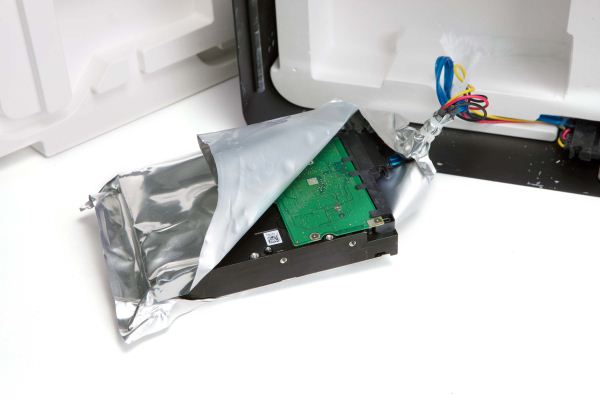ioSafe SoloPRO: Disaster Proofing Your Storage Needs
by Ganesh T S on April 9, 2012 6:00 PM EST- Posted in
- Storage
- IT Computing
- ioSafe
The SoloPRO consists of two pieces of steel which interlock and are held together with screws. Inside it is the DataCast (ioSafe's trade name) endothermic insulation (which was described in the last discussed patent). Since hard drives are comparatively low power (in the 5-20 W range), a hatchless design with no moving parts is used. The HydroSafe (again, ioSafe's trade name) barrier is the water resistant enclosure described in one of the inventions listed in the second patent. The photograph below shows the internals of the ioSafe SoloPRO. Note the two zip ties used to seal the wires going into the waterproof pouch.
We looked at the technology behind ioSafe's products in the previous section and had a look into the internals just now. But, how effective is the technology? Instead of subjecting the unit to fire and water damage, and just presenting readers with results which a number of other excellent reviews have already done, we decided to concentrate on covering the technology behind the unit. That said, we went through a large number of ioSafe videos on YouTube and decided to present one particular destruction / recovery attempt which, we believe, brings across the disaster proof nature of ioSafe's offerings in a realistic scenario. Embedded below is the video review of an ioSafe unit by GearDiary's Larry Greenberg
The above video also shows how to recover the data from an ioSafe unit subject to fire and water damage. In almost all cases, however, the users just need to mail the drive back to ioSafe for data recovery (and getting another ioSafe unit with that data).
There are other videos on YouTube showing how ioSafe's offerings stand up to various destruction attempts, and we believe there was nothing we could do in our testing that could one-up those professional destruction attempts.
Home users dealing with small amounts of data can always back up their contents using cloud services like Dropbox and Box.net. Serious businesses always have an off-site tape backup or some other similar mechanism for data backup. However, the former is not suitable for large amounts of data (say, more than a few hundred GBs), and the latter is not suitable for making a disaster proof copy of recently changed files. Keeping this in consideration, it is also necessary to evaluate the performance metrics of the unit.











34 Comments
View All Comments
ant6n - Monday, April 9, 2012 - link
Most of the inventions related to cooling the drive while fire/water-proofing will be moot once SSDs get cheaper. Maybe they should focus on finding ways to redundantly store data in SSDs in a fire/water proofed way.ganeshts - Monday, April 9, 2012 - link
ioSafe has a disaster proof SSD solution also. Why do you think fire/water proofing is not necessary for SSDs?bji - Monday, April 9, 2012 - link
I think you misunderstood the comment.The comment was that COOLING THE DRIVE is not necessary for an SSD which makes it easier to develop fire/water proof solutions based on SSDs.
The comment was NOT that fire/water proofing is not necessary for SSDs.
B-Unit1701 - Tuesday, April 10, 2012 - link
I would imagine that is the basis for the internal drive plugged at the end of the article. A standard sized SSD in a 5/12" vault.PostToaster - Tuesday, April 10, 2012 - link
bji -
Mmh didn't misunderstand your comment. You mis-wrote it. You should have said "trivial" instead of "moot". They mean different things.
robb.moore - Tuesday, April 10, 2012 - link
Hi bjl-Cooling electronics is always important as HDDs, like SSDs, all generate heat. SSDs generally do generate less heat than HDDs at idle but when operating - they both use about 4-5W of energy. Even 1W in a small enough enclosure can get incredibly hot if insulated.
ioSafe technology is about how to built a heat generating computer in a perfectly insulated box. It's tricky to do both at a price point that everyone can afford. Thanks for your comments!
-Robb
Robb Moore
CEO
ioSafe
Samus - Thursday, April 12, 2012 - link
I agree. 5-watt SSD's get pretty hot, you can't just put them in an air-tight enclosure. I've read a number of stories involving OCZ's drives (among the highest wattage drives) failing in laptops, especially older Thinkpad's that were designed for 4200RPM drives.g00ey - Thursday, April 12, 2012 - link
I'm still concerned about the integrity of data storage. It is a well known fact that storage devices are prone to failure no matter how fire- and waterproof you make them. This means that some form of redundancy is required and at the moment only ZFS can deliver proper protection against data corruption.File systems such as BrtFS and HammerFS look promising but it will take years until they can deliver the same data integrity protection as ZFS currently does.
robb.moore - Thursday, April 12, 2012 - link
Agreed - redundant copies of the data is VERY important. (See 3-2-1 Backup in the comments further down.)The simple choice with ioSafe is that if you're going to buy an external hard drive anyway...would you like the RED hard drive or the FIREPROOF WATERPROOF hard drive for your data.
-Robb
Robb Moore
CEO
ioSafe
JNo - Monday, April 9, 2012 - link
Off site cloud storage (as well as onsite secondary backup system) is surely the way to go? Onsite backup can burn down too but one or more cloud systems are unlikely to go down simultaneously. Now if only it was cheap enough to back up my movie collection as well as my documents :)